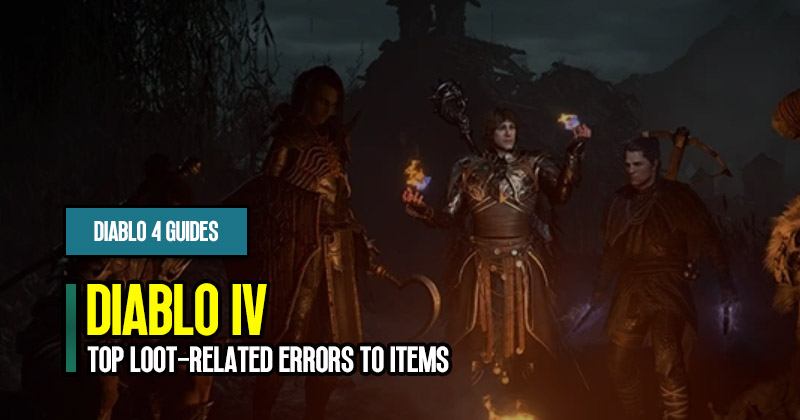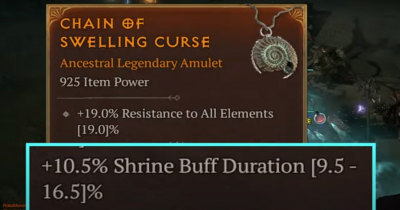Diablo 4 Mistakes Loot Guide: Top loot-related Errors to Items
In Diablo 4, making informed decisions about your loot is crucial for optimizing your gameplay experience. To help you avoid common mistakes, we've compiled a guide to the top three loot-related errors players tend to make. By learning from these pitfalls, you'll be better equipped to handle your items, maximize your crafting materials, and accumulate gold. Let's dive in!
- Salvage or Sell? Making the Right Choice
- Overlooking Super Unique Monster Spawns and Their Valuable Drops
- Unleashing the Power of Crafting Tricks
- Neglecting Imprinting and Extracting Aspects
- Failing to Utilize Gems
- Ignoring Affixes
- Enchanting Affixes Inefficiently
- Improper Timing for Enchanting and Aspect Usage
- Understanding Nightmare Sigils and Dungeons
- Leveling Up Glyphs
- Avoiding Low-Level Sigils
- Balancing Difficulty and Progress
- Crafting Higher-Tier Sigils
- Prioritizing Glyph Progression
- Utilizing Helltide for Gear Upgrades

↖ Salvage or Sell? Making the Right Choice
One of the most common dilemmas players face is whether to salvage or sell the items they find. The decision can be tricky, but we'll share our strategy to ensure you have abundant crafting materials and gold.
When you salvage armor, you obtain raw hides, while salvaging weapons or jewelry yields resources like iron and silver chunks. It's important to note that there are maximum caps for each material. If you reach these limits, you can visit The Alchemist to combine them and upgrade your ore to silver or your raw hides to leather. This approach allows you to continue gathering more materials.
When it comes to acquiring Diablo 4 gold, selling items is the primary method. Gold is used for upgrading gear and refunding Paragon nodes and skills in the skill tree. Since these activities can be quite expensive, it's crucial to accumulate a substantial amount of gold. As you progress in the game and reach a point where you have ample crafting materials, consider selling all your items. Unique items, in particular, fetch a higher price compared to rares. By selling strategically, you can ensure a steady influx of gold to support your endeavors.
↖ Overlooking Super Unique Monster Spawns and Their Valuable Drops
Many players are unaware of super unique monster spawns and the incredible items they drop. These monsters consistently appear in the same location and always drop the same item, making them valuable targets for loot enthusiasts. The quality of the items they drop varies depending on your level and the world tier you are in.
While these monsters scale to your level, it's important to note that they drop the highest item power loot in the game. When you reach the maximum level and encounter these monsters, the items they drop will have higher item power than those obtained from regular monsters. These drops have an interesting feature: instead of four stats, they possess three, but these three stats can roll higher than any other stat on a four-stat item.
Moreover, rerolling affixes on items dropped by rare monsters becomes significantly cheaper at higher levels. Investing in rerolls allows you to obtain powerful affix combinations that can significantly enhance your character's capabilities. Explore the Trophy Hunter challenge in the in-game map to discover a comprehensive list of these rare monsters.
↖ Unleashing the Power of Crafting Tricks
Crafting plays a vital role in Diablo 4, and understanding item break points and crafting tricks can give you a significant edge. There are six item break points, each representing a specific range of item power. Crossing these breakpoints through crafting allows you to access higher ranges of stat rolls.
For example, upgrading a weapon with 612 item power to surpass the 625 breakpoint triggers a reroll of all the item's stats, providing a chance for higher values. While getting lower rolls on upgraded items is possible, the benefits of reaching higher breakpoints usually outweigh the risks. This strategy is especially effective for items that had initially rolled low stats.
Regular items can be upgraded a maximum of four times, while sacred or ancestral items can be upgraded five times. However, by utilizing sacred or ancestral legendary aspects on regular rares, you can convert them into sacred or ancestral legendary items. This opens up the possibility of obtaining five upgrades even for regular items, which can be invaluable if you've found an item with perfect affixes but low item power.
↖ Neglecting Imprinting and Extracting Aspects
One common mistake, especially among lower-level characters, is misunderstanding the imprinting and extraction of aspects. To clarify, aspects obtained from completing dungeons in the Codex of Power have infinite uses. While they always offer the lowest percentage roll, they still provide significant benefits. Lower-level characters should not hesitate to imprint aspects on their gear, even if the rolls are not optimal. It makes a noticeable difference in power, allowing you to progress through early game content more efficiently.
↖ Failing to Utilize Gems
Gems play a crucial role in enhancing your character's abilities. Many players tend to hoard gems, waiting for an excessive amount before using them. However, it's essential to slot gems into your gear consistently, regardless of your character's level. Different gems offer specific benefits, and by utilizing them in all available slots, you significantly increase your overall power. Moreover, you can easily retrieve gems from gear by salvaging items, saving you gold and inventory space.
↖ Ignoring Affixes
Affixes on gear can greatly impact your character's performance, but they often go unnoticed. When comparing items solely based on DPS or appearances, you might overlook the valuable bonuses provided by specific affixes. Pay close attention to the affixes that synergize with your build and playstyle. By stacking compatible affixes across multiple pieces of gear, you can achieve significant damage bonuses and optimize your character's effectiveness.
↖ Enchanting Affixes Inefficiently
Enchanting affixes can be a costly endeavor if not approached strategically. Understanding the item power level tiers is crucial when enchanting gear. Upgrading an item's power level to cross into a higher tier can unlock substantial increases in affix ranges. By aligning your gear with these tiers, you can achieve more significant benefits. Ensure that you upgrade items strategically to maximize the potential of your affixes.
↖ Improper Timing for Enchanting and Aspect Usage
Knowing when to enchant your gear and when to utilize aspects is essential. For levels 1 to 50, prioritize aspect usage rather than extensive gear upgrading. Aspects provide significant power boosts, making early-game content more manageable. Extract and save high-max roll aspects for later use in endgame gear. Once you reach level 50, focus on upgrading gear and applying aspects to all available slots. This ensures your character reaches its full potential and excels in combat.
↖ Understanding Nightmare Sigils and Dungeons
Nightmare sigils are an integral part of progressing in Diablo 4. By completing Nightmare dungeons, you can level up your glyphs, acquire higher-tier sigils, and gain significant experience boosts. The first step is to unlock nightmare dungeons by completing activities related to the Tree of Whispers. These initial sigils start at tier one and gradually increase in difficulty and rewards.
↖ Leveling Up Glyphs
One of the critical mistakes players make is not prioritizing the leveling up of their glyphs. To maximize the value of your glyphs, aim to level them up to at least level 15. This requires a considerable amount of experience, and simply grinding on low-level sigils will result in slow progress. By jumping up to higher difficulty levels, such as Nightmare dungeons in the range of six to ten, you can gain significant experience and make substantial progress on your glyphs.
↖ Avoiding Low-Level Sigils
If you find yourself in World Tier three or higher and have progressed significantly in the game, engaging with low-level sigils can be counterproductive. These sigils are restricted to lower difficulties, resulting in lower-tier enemies and suboptimal drops. Instead, consider salvaging low-level sigils for sigil powder, which can be used to craft higher-tier sigils. By doing so, you can skip several levels and challenge yourself with more rewarding dungeons.
↖ Balancing Difficulty and Progress
Finding the right balance between difficulty and progress is crucial. While you don't want to struggle with enemies that are too strong, fighting enemies at the same level or lower will yield less experience. Experiment with different difficulty levels and aim for dungeons where you can comfortably clear enemies without dying frequently. This way, you can maximize your experience gains and overall progress.
↖ Crafting Higher-Tier Sigils
As you progress through Nightmare dungeons, you may acquire new sigils. If you find that a particular difficulty level becomes too easy, consider breaking down lower-level sigils and using the sigil powder obtained to craft higher-tier sigils. By doing this, you can challenge yourself with more difficult dungeons, face higher-level enemies, and gain greater rewards and experience.
↖ Prioritizing Glyph Progression
Glyph progression is crucial for unlocking the full potential of your character. Focusing on leveling up two or three glyphs to level 15 is highly recommended. This allows you to extend the range of bonuses and stats provided by glyphs, significantly enhancing your character's effectiveness. Prioritize leveling up glyphs that offer bonuses suited to your build and playstyle, such as those that increase critical damage or enhance your elemental abilities.
↖ Utilizing Helltide for Gear Upgrades
Don't overlook the benefits of Helltide systems for gear upgrades. If you're in need of specific gear improvements, such as a new ring or weapon, Helltide can be a valuable resource. Focus on acquiring and upgrading items through Helltide activities, such as the Focus Fire Rings. By leveraging Helltide effectively, you can fill gear gaps and increase your overall power level.
Conclusion:
By avoiding these top three loot-related mistakes, you'll enhance your Diablo 4 experience and make better decisions regarding your loot management. Whether it's salvaging or selling, understanding super unique monster spawns, or leveraging crafting tricks, you'll be well-equipped to navigate the treacherous realms of Sanctuary. Remember, loot is your key to power and success in Diablo 4.
Most Popular Posts
- Diablo 4 Addons: Useful Website for Build and Crafting
- Diablo 4 Keybinds Mouse Wheel and Left-click Setting Up Guides
- Diablo 4 Ruins of Eridu Dungeon: Farming Legendaries, Unique Items, Gold, and XP
- Diablo 4 EndGame Boss Echo of Lilith Fight Challenge Guides
- Diablo 4 Items Guide: How to Evaluate Item Quality
- Diablo 4 ALT Character: Tips for Efficient Leveling and Loot Farming
Popular Category Lists
- Path of Exile / (873)
- Diablo IV / (702)
- Runescape / (344)
- New World / (172)
- WoW Classic SoD / (171)
- Guild Wars 2 / (159)
- Elder Scrolls Online / (138)
- FFXIV / (135)
- World of Warcraft / (65)
- WOW Classic / (43)
- Elden Ring / (40)
- Throne and Liberty / (36)
- SWTOR / (35)
- Albion / (35)
- Last Epoch / (32)
- League of Legends / (30)
- Dark and Darker / (28)
- Fallout 76 / (27)
- WotLK Classic / (23)
- Genshin Impact / (22)





 0
0









